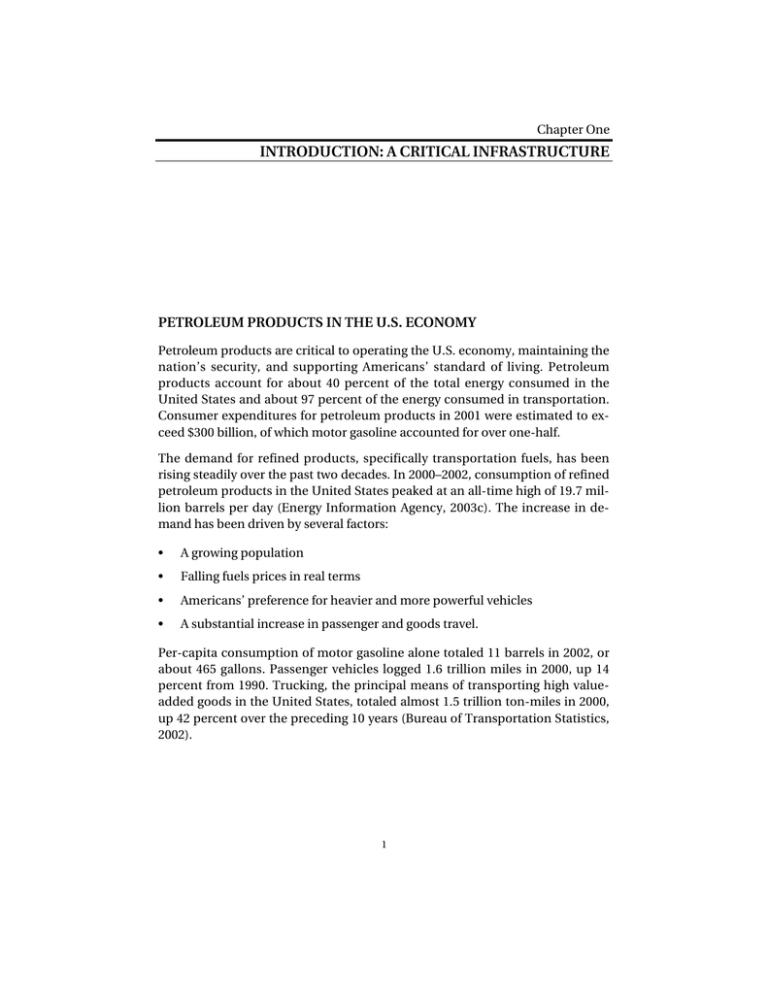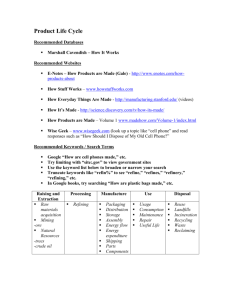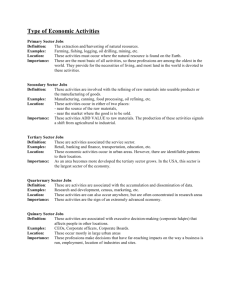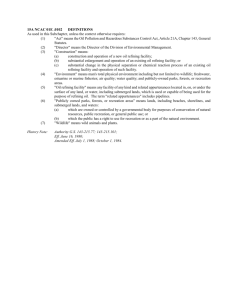INTRODUCTION: A CRITICAL INFRASTRUCTURE PETROLEUM PRODUCTS IN THE U.S. ECONOMY
advertisement

Chapter One INTRODUCTION: A CRITICAL INFRASTRUCTURE PETROLEUM PRODUCTS IN THE U.S. ECONOMY Petroleum products are critical to operating the U.S. economy, maintaining the nation’s security, and supporting Americans’ standard of living. Petroleum products account for about 40 percent of the total energy consumed in the United States and about 97 percent of the energy consumed in transportation. Consumer expenditures for petroleum products in 2001 were estimated to ex­ ceed $300 billion, of which motor gasoline accounted for over one-half. The demand for refined products, specifically transportation fuels, has been rising steadily over the past two decades. In 2000–2002, consumption of refined petroleum products in the United States peaked at an all-time high of 19.7 mil­ lion barrels per day (Energy Information Agency, 2003c). The increase in de­ mand has been driven by several factors: • A growing population • Falling fuels prices in real terms • Americans’ preference for heavier and more powerful vehicles • A substantial increase in passenger and goods travel. Per-capita consumption of motor gasoline alone totaled 11 barrels in 2002, or about 465 gallons. Passenger vehicles logged 1.6 trillion miles in 2000, up 14 percent from 1990. Trucking, the principal means of transporting high value­ added goods in the United States, totaled almost 1.5 trillion ton-miles in 2000, up 42 percent over the preceding 10 years (Bureau of Transportation Statistics, 2002). 1 2 New Forces at Work in Refining CHANGE AND CHALLENGES IN REFINING The United States is widely recognized as having the largest, most sophisti­ cated, and most productive petroleum refining infrastructure in the world. (Key facts regarding the U.S. refining industry are presented in Table 1.1.) Over the past two decades, the pace of change in the industry has accelerated. First, the industry has experienced an unprecedented wave of consolidation and corpo­ rate retrenchment since 1998. An industry once led by a half-dozen vertically integrated majors (large firms that produce crude oil and refined products) has bifurcated into one characterized by a few “super-majors” and an array of mid­ size and small refiners focused largely on refining and marketing within specific regions. Second, environmental regulations—clean air objectives in particular—have affected operations. In the 1980s, lead was phased out of gasoline. In the 1990s, a number of specifications for cleaner gasoline and diesel were phased in as federal, state, and local authorities intensified their efforts to re­ duce vehicle emissions and improve air quality. In addition, refineries have be­ come subject to more-stringent regulations governing their emissions. Table 1.1 The U.S. Refining Industry at a Glance, 2002 Number of firms engaged in refining Number of operable refineries Crude oil input to refineries Share of petroleum products in total U.S. energy consumption Average pump price of motor gaso­ line, including taxes Estimated consumer expenditures for petroleum products Refining industry’s share of the cost of a gallon of gasoline, 2001 Average net margin from the pro­ duction and sale of refined prod­ ucts for medium- and large-size firms, 2001 58 153 14.9 million barrels/day 40 percent $1.44/gallon $300 billion $0.34, or 25 percent $0.066/gallon SOURCES: Energy Information Administration (2002a, 2003a, 2003c), Higgins (2003). The U.S. petroleum refining industry will face a number of new challenges in the near future. Over the next several years, the industry will be upgrading its facilities to produce ultra-low-sulfur gasoline and diesel fuel; to phase out methyl tertiary butyl ether (MTBE) as a gasoline additive; to blend in ethanol as an oxygenate; and to further reduce the environmental impacts of plant opera­ tions. How and when some of these initiatives will be implemented have cre­ ated significant uncertainty in the industry. Over the longer term, the Energy Introduction: A Critical Infrastructure 3 Information Agency (2003b) projects that, based on current trends, consump­ tion of petroleum products in the United States could increase by 47 percent, or 1.6 percent annually, between 2001 and 2025. During this period, motor vehicles powered by fuel cells and other emerging technologies could penetrate the market, raising alternative scenarios concerning the types and volumes of fuels they will consume and how they will be manufactured and distributed (Office of Transportation Technologies, 2001). Meanwhile, industry consolidation is ex­ pected to continue. Despite the changes the refining industry has experienced, business, govern­ ment, and consumers in the United States have enjoyed reliable supplies of fu­ els at relatively stable prices that have decreased in real terms over time. The average pump price (including taxes) for regular gasoline in 2002 was $1.44. Adjusted for inflation, this price was about where prices were 40 years earlier and 35 percent lower than when prices peaked in 1981.1 In recent years, however, the fluctuation of refined product prices has become more pronounced than historically has been the norm, placing the refining in­ dustry in the policy spotlight. In California and parts of the Midwest, several significant price spikes occurred in spring and summer 2000 and 2001 as a re­ sult of refinery shutdowns. In the Chicago-Milwaukee metropolitan areas, the price of regular gasoline peaked at over $2.00 per gallon, up from about $1.30 six months before. Refining industry representatives have argued that these events may presage additional supply disruptions and greater price volatility in the future. A number of studies have raised similar concerns: • An analysis by an advisory panel for the Secretary of Energy asserted that the supply chain is increasingly at risk because of environmental regula­ tions and other policy constraints and warned of intermittent “supply im­ balances” and higher prices for fuels (National Petroleum Council, 2000). • A study commissioned by the California Energy Commission observed, “The combination of restricted refining capacity, inadequate logistics in­ frastructure, and commercial barriers has made the California gasoline market increasingly unstable, with even small supply disruptions causing major price swings” (Stillwater Associates, 2002). • An investigation by the Federal Trade Commission (2001a) blamed the price spikes in the Midwest on a number of factors, including industry forecasting errors, unexpected disruptions in gasoline manufacturing and distribution, and strategic and tactical moves by refiners. The agency’s chairman noted ______________ 1Although prices have remained relatively steady, refined products have undergone significant im­ provements in quality, such as the banning of lead from gasoline in the 1980s. 4 New Forces at Work in Refining Gasoline prices are widely posted, and U.S. consumers expect public officials to ensure the reliability and affordability of supplies. in particular that “the underlying lack of U.S. refinery capacity threatens similar price spikes in the future” (Federal Trade Commission, 2001b). To address these issues and other concerns, the Bush administration’s National Energy Plan recommended several initiatives targeted at the manufacturing and distribution of refined products (National Energy Policy Development Group, 2001). Key recommendations included the following: • Explore ways to increase the flexibility of the fuels distribution infrastruc­ ture, improve fungibility, and provide added gasoline market liquidity. • Provide more regulatory certainty to refinery owners. • Adopt comprehensive regulations and consider the rules’ cumulative im­ pacts and benefits. • Review New Source Review regulations, including administrative interpre­ tation and implementation. • Maintain the Northeast Heating Oil Reserve. Introduction: A Critical Infrastructure 5 A CRITICAL INFRASTRUCTURE Though petroleum refining is considered to be a basic or commodity industry, refiners’ role in the economy is quite complex. • Refineries produce critical intermediate products to industry and cus­ tomers that have no easy substitutes in the short term. Businesses depen­ dent on trucking and transport, for example, are immediately affected by supply disruptions. • The refined products supply chain is characterized by rapid product turnover. Inventories of refined products on hand at any point in time are small relative to demand because of their physical qualities and the unwill­ ingness of producers to keep large stocks on hand. Disruptions in refinery operations can have immediate effects on prices and supplies. • The U.S. economy and the perceptions of the nation’s public are sensitive to price and supply disruptions because such disruptions affect, among other things, the bottom lines of businesses and the disposable income of consumers. If disruptions are frequent, prolonged, or widespread, they can undermine the nation’s economic well-being and sense of security. • Gasoline prices are one of the most common yardsticks of inflation and are regularly tracked in the media. Although the prices of refined products have remained relatively steady in real value over the long term, short-term per­ turbations of more than a few cents make the headlines. Given this real-time supply, demand, and information environment, consumers of petroleum products in the United States expect that, as with water and elec­ tricity, public officials will ensure the reliability and affordability of supplies. Oil industry research, analyses, and policy dialogs conducted in both the pri­ vate and public sectors tend to emphasize the natural resource side of the business—upstream crude oil exploration and production. Much less analysis and discussion is devoted to oil companies as the downstream manufacturers of in­ termediate and finished petroleum products. Research and discourse on refin­ ing often focus on short-term challenges associated with regulation. In the wake of September 11, 2001, officials concerned with critical infrastructure security have also paid greater attention to protecting the petroleum products supply chain from terrorist attacks. Nevertheless, the critical market, operations, and technology trends in refining and their implications for the long-term health and sustainability of refiners remain outside the view of most public-sector decisionmakers. This report is intended to address that shortcoming. 6 New Forces at Work in Refining ABOUT THE STUDY Task The U.S. Department of Energy (DOE), along with other federal agencies, has been tasked with promoting “dependable, affordable, and environmentally sound energy for the future” (National Energy Policy Development Group, 2001). In 2001, RAND was requested by the National Energy Technology Labo­ ratory within DOE’s Office of Fossil Energy to conduct a series of in-depth discussions with key members of the U.S. petroleum refining industry to deter­ mine how they view the future and their ability to produce dependable, afford­ able, and environmentally sound energy supplies. To these points, this report answers several questions: • How do market, operations, technology, and regulatory trends impact re­ fining firms and their operations? • How is the refining industry responding to these opportunities and chal­ lenges? • What issues and trends merit attention from DOE given its mandate to promote dependable, affordable, and environmentally sound energy for the future? Purpose For the past several years, the Department of Energy’s technology research and development efforts concerning refining have been under reappraisal. In fiscal year 2003, for example, the Fossil Energy program started shifting its fuels re­ search priorities from ultra-clean forms of petroleum-based fuels to a new effort focused on hydrogen production for fuel cell applications. Despite a long his­ tory of interaction between DOE and the refining industry, their communica­ tions have tended to focus on short-term and technical issues, such as produc­ tion and product trends and compliance with regulations. With that fact in mind, this effort was undertaken to provide the Fossil Energy program and the greater Department of Energy an additional avenue of information: an up-close and high-level perspective on the views of refining industry leaders about longer-term trends in their sector. By highlighting a range of critical questions concerning refined product supply that affect the health of the U.S. economy and the security of the nation, this report is intended to help DOE decisionmak­ ers address broad questions about the alignment of the agency—not only on refining technology research and development, but also on refined products markets and prices, investment and economic development, environmental protection, and trade policy. Introduction: A Critical Infrastructure 7 Several other agencies and offices with significant ongoing interests in refining and refining-related activities—such as the U.S. Environmental Protection Agency, the White House Office of Science and Technology Policy, the Depart­ ment of Justice, and the Federal Trade Commission—may also be interested in the results of this study. The Department of Homeland Security and the De­ partment of Defense may benefit from the insights presented herein, given their interests in maintaining reliable supplies of fuels and protecting the nation’s critical infrastructure. The report also is intended to inform staff members and policymakers in Congress as well as in state governments—for whom assuring the reliability, low cost, and reduced environmental footprint of petroleum products are important objectives—but who often do not have the opportunity to examine refining-industry trends in depth. Finally, this report should also help refining-industry executives, researchers, and stakeholders obtain a broad view and understanding of business and oper­ ations trends. Although refining operations share many technologies and pro­ cesses, the industry is highly competitive and diverse; according to industry ex­ ecutives with whom we spoke, information-sharing among firms is limited. Thus, industry decisionmakers can benefit from their colleagues’ experiences and perspectives presented herein. How the Study Was Conducted This study was modeled after several previous RAND studies on trends in criti­ cal industries (Peterson, LaTourrette, and Bartis, 2000; Resetar, 1999; Popper, Wagner, and Larson, 1998). RAND researchers met with and led structured discussions with 72 representatives from 40 organizations across a broad spectrum of the refining industry. Organizations represented in the study included 18 operating companies engaged in the refining or manufacturing of intermediate and final products. These firms accounted for over three-quarters of total U.S. refining capacity in 2002. The RAND team met with 10 firms that provide refineries with engineering, planning, and construction services; process technologies and equipment; and process consulting and services. The information gathered from these two groups comprises the bulk of the views presented in this report. In addition, for background information and context, we met with seven organizations and government agencies closely involved with the refining industry. Finally, five individuals heading university departments with strong programs in refining were contacted to obtain their perspectives on the long-term supply of advanced refining technologies and trained personnel. RAND contacted all large and mid-size refiners in the United States, as well as a significant number of small and niche operators. We also contacted a wide di­ 8 New Forces at Work in Refining versity of technology and services providers, including all the major engineer­ ing, planning, and construction firms. The individuals within the companies participating in the RAND study were selected on the basis of their leading positions and for their ability to think broadly and creatively about technology and management issues. The majority were drawn from executive ranks and included chief executive officers, presi­ dents, chief operating officers, and vice presidents. We also spoke with man­ agers responsible for strategic planning, refining operations, research and de­ velopment, and for the acquisition, sales, and service of technology products. RAND identified an initial pool of individual candidates with the assistance of the National Petrochemical and Refiners Association, the American Petroleum Institute, and an industry consultant. During the discussion phase, participants identified other individuals and organizations (in the case of supplier firms) as being particularly innovative or having important experience, and in many cases these firms were added to the participant roster. The organizations and individuals that agreed to participate are listed in Appendix A. The industry discussions were conducted between February and July 2002 and consisted of structured, confidential conversations that typically were held on the participants’ premises and lasted from 90 minutes to two hours.2 Subjects addressed in the discussions included markets for refined products, corporate management, refinery operations, the quality and quantity of innovations that are currently in different stages of development and expected to be used in the future, and government policy and regulation. (The discussion protocol is pre­ sented in Appendix B.) We sought to address the specific themes identified in the protocol, but we let the discussants determine the issues that were valuable to highlight and those that could be disregarded within the brief meeting time. Although keeping the meetings concise facilitated contacting a wide range of executives, it also limited the amount of time we could devote to any one topic.3 Scope Study participants represent a broad spectrum of the petroleum refining indus­ try. During the time of the study, the largest operating company in the RAND sample managed a number of large refinery assets nationwide with a total crude oil distillation capacity of 1.9 million barrels per day. The smallest partic­ ______________ 2Logistical constraints limited the RAND team’s ability to involve several key participants. To over­ come this limitation, one operating company and one supplier company discussion and all of the university discussions were conducted by telephone. 3For example, the RAND protocol did not call for quantitative assessments of planned investments or expectations of their returns. Obtaining such information would have been of great value in as­ sessing refining trends but was beyond the scope of the study. Introduction: A Critical Infrastructure 9 ipating refiner managed one refinery with a capacity of 24,000 barrels per day. Refiners participating in the study had operations located in all regions of the United States and manufactured a diverse slate of products, including trans­ portation fuels (such as gasoline, diesel, and jet fuels), home heating oil and in­ dustrial fuels, asphalt, lubricants and waxes, and chemical feedstocks (intermediate products that then go into the production of petrochemical products such as plastics and fertilizer). This project focused on refining operations—the petroleum downstream. The subjects of crude oil supply (the up­ stream) and refined product handling beyond the refinery gate are addressed only as they affect refinery operations. The list of participating companies should not be considered representative of the entire U.S. refining sector. In particular, the sample of refiners is biased to­ ward large and mid-size companies, which account for a substantial and grow­ ing share of domestic production. The United States counts over 30 small oper­ ating companies with production capacities below 100,000 barrels per day— many of which specialize in asphalt, lubricants, and other niche products. Of this group, 11 firms were contacted by RAND but only three elected to partici­ pate. The sample of participating technology suppliers spans a range of spe­ cialties and sizes. RAND sought out representatives in executive- and management-level posi­ tions to obtain a broad, high-level view of critical issues and trends within the context of the participants’ firms, their market segments, and the refining in­ dustry as a whole. As a result, the discussions focused more on broad trends and often did not entail detailed, hands-on knowledge of specific market, regu­ latory, or technical issues. On this point, we emphasize that the list of issues and trends identified in this report is not intended to be exhaustive. Rather, it summarizes and synthesizes the perspectives of a sample of industry represen­ tatives, based on their understanding of their firms’ activities and the industry at large. The absence of a particular topic in the report should be interpreted not as an intentional omission but as an indication that it was not cited as criti­ cal during the discussions. During the course of the discussions, industry leaders typically focused on cur­ rent issues and trends, as well as those foreseen over the next few years (i.e., 2004–2006). This focus reflects executives’ and managers’ time horizons in a competitive and volatile business environment. Beyond day-to-day business concerns, industry decisionmakers’ focus and calendars are closely pegged to the regulatory agenda. The year 2006 is significant for most refiners because of the mandated introduction of ultra-low-sulfur diesel fuel production. In a few instances, however, the discussants extended their horizon to 10–20 years— 10 New Forces at Work in Refining Operating companies participating in the RAND discussions accounted for over three-quarters of U.S. refining capacity in 2002. usually when they were addressing fuel demand trends and the prospects of fuel cell–powered vehicles. This report does not present an industry consensus view. Although we discov­ ered many points of convergence during the 40 discussion sessions, we also ob­ served many divergent perspectives. For example, some discussants spoke with great concern about impending cleaner fuels regulations, whereas others indi­ cated that they were not a serious stumbling block. Indeed, many participants highlighted the fact that refining is marked by a wide diversity of industry members and views. We highlight converging and conflicting views to illustrate the breadth of thought and experience across the industry. Because this report is intended to provide public-sector decisionmakers with an up-close and high-level perspective on the views of refining industry leaders, we have provided supplemental factual information and analysis sparingly—to contextualize or clarify industry views. The views of other interested parties and stakeholders—community groups, environmental advocates, consumers, labor, and local, state, and federal officials—should also be considered in formulating plans and policies regarding the refining industry. Introduction: A Critical Infrastructure 11 ORGANIZATION OF THE REPORT Chapter Two provides a structural analysis of the refining industry as a business and market. Key issues addressed include leaders’ perceptions of the business environment, industry consolidation and restructuring, and the evolution in petroleum products markets. Chapter Three examines operations-level issues and trends, especially as they concern the industry’s ability to keep up with projected demand and environ­ mental regulations. Subjects covered include trends in capacity utilization and additions; critical technologies, such as catalysts; and maintenance and reliabil­ ity practices. Production of potential fuels of the future—hydrogen and liquid fuels for fuel cells—are also addressed. The chapter closes with a discussion of research and development and human capital availability. Chapter Four focuses on regulation, which we present in the context of four broader themes raised in the RAND discussions: return on investment, capital availability, flexibility, and uncertainty. Most industry participants focused on two regulatory issues—MTBE phase-out and the ultra-low-sulfur diesel rule. Both issues are discussed, including the possibility of supply shortfalls. Chapter Five synthesizes and summarizes the key findings and trends the dis­ cussions brought to light. Drawing on those findings, we present a number of key questions that may merit close attention by the Department of Energy and other decisionmakers now and in the coming years. Appendix C is a brief primer on the major processes and technologies involved in refining. It is intended to serve as a handy reference for those in the policy community who have an interest in refining and products supply but are not familiar with the manufacturing process.



